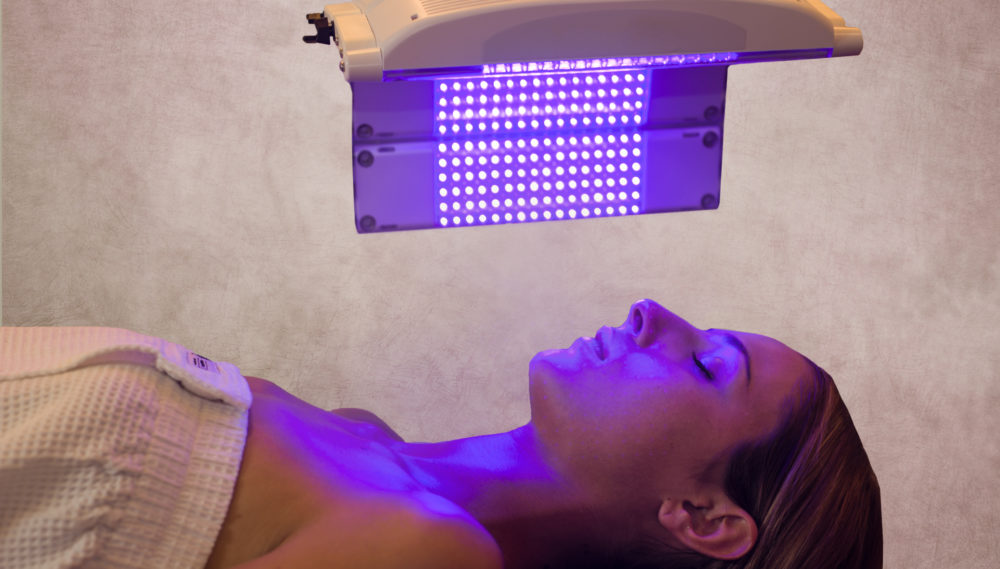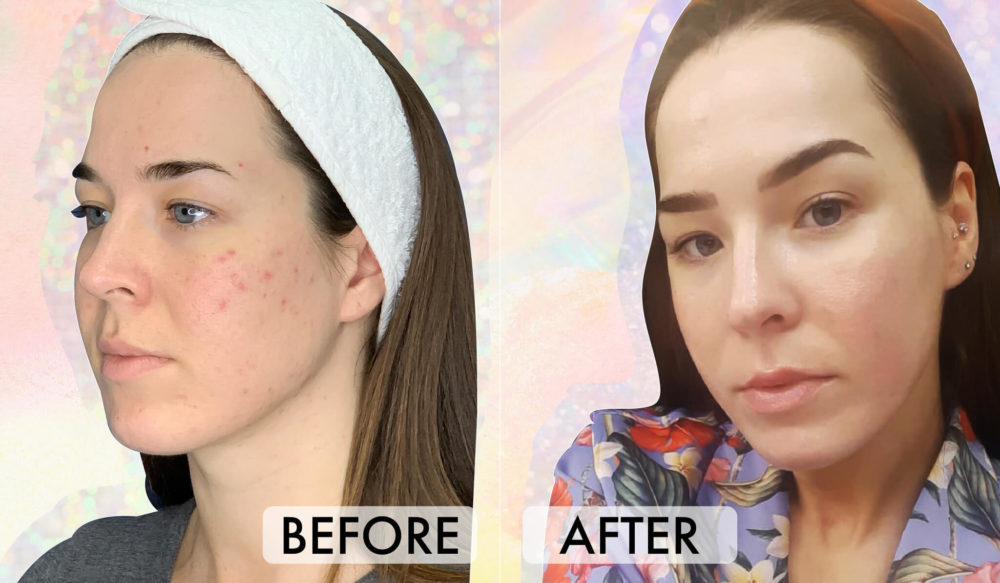Blue Light: The Good, The Bad, And What You Need To Know

If you’ve done any research on blue light, you might have left feeling a little bit confused. On one hand, you’ve got warnings of blue light damage from the sun and our screens, and on the other, you’ve got blue light therapy, which is used to treat acne breakouts. So… Is blue light good for you or bad news for your skin? We hit up a couple skincare experts to set the record straight.
What is Blue Light, and Why Does it Get a Bad Rap?
There’s an entire rainbow spectrum of light (remember ROYGBIV?), and blue is on that spectrum. There’s also red, purple, and yellow light, and each has a different wavelength and amount of energy. Blue light is the portion of the visible light spectrum with the shortest wavelengths and highest energy.
“Blue light is part of sunlight, and is also emitted by indoor light bulbs, televisions, cell phones, and computers,” says Dr. Jessie Cheung, a board-certified dermatologist in Chicago, Illinois. “Blue light passes through your cornea and lens to reach your retina, and too much exposure can damage your vision or cause eye-strain. [Some studies] have also shown that blue light exposure can age our skin via oxidative stress and free radical formation.
Dr. Cheung adds that the reason why we’re seeing more data emerge on this topic is largely because we’re all spending much more time in front of computers, tablets, and cell phones.
 Source: Shutterstock
Source: Shutterstock
While the sun is still the OG and biggest source of blue light-related damage, the additional exposure to screens throughout the day and night further damage our collagen, elastin, pigment, and eyes. It also disturbs the circadian rhythm of our skin repair and body, which has all kinds of unwanted effects (like bad sleep, bad skin, and even weight gain).
Protecting Yourself from Blue Light Damage
For the above reasons, there’s been a notable increase in the number of topical products and other devices meant to shield your eyes and skin from blue light.
These include sunscreens, such as Supergoop’s Unseen Sunscreen SPF 40, $17, as well as cosmetics and other skincare products such as Cover FX Water Cloud Primer + Pollution & Blue Light Defense, $38. You’ll also find non-prescription glasses that are meant to protect your eyes from blue light damage. Quay makes a really fun line and the entire Felix Gray lineup shields you from blue light.
Dr. Melanie D. Palm, a board-certified dermatologist and cosmetic surgeon, says that physical sunscreens containing zinc oxide and titanium dioxide have been found to block blue light in addition to other types on the rainbow spectrum. “You should combine these sunscreen agents with antioxidants, such as vitamin C, vitamin E, and polyphenols, to reduce oxidative stress on skin cells resulting from blue light exposure.”
Another thing you can do is limit your time with your screens in general or adjust the blue light settings on your devices. You can also shift to the night setting, which can help cut down on the blue light emission.
What About Digital Devices and Treatments That Use Blue Light?
All this is pretty confusing when you consider the fact that there are digital devices out there – some of which you can purchase and bring straight into your home – that utilize blue light to treat your skin for acne. Examples include Foreo’s Espada Blue Light Acne Treatment, $149, QuasarMD’s Clear Rayz Compact 2-in-1 Treatment for Acne Blemishes, $199, and Dr. Dennis Gross Skincare SpectraLite™ FaceWare Pro, $435.
Posts You'll Love:
Research popularized about a decade ago pioneered blue light therapy as a treatment option for acne, especially in patients where traditional topical or oral therapies are not an option or not desired (such as pregnancy). That’s why the above devices, and clinical in-office blue light treatments, exist.
“In blue light therapy used for acne treatments, higher strength pure blue light is targeted at the skin for a very short time. This has a much different, and beneficial effect on the skin [compared to] long-term, low-grade cumulative blue light exposure from devices,” says Dr. Palm. “The purity of the light, the intensity of the light, and the length of exposure differs greatly between therapeutic devices that help the skin, versus devices that might cause premature aging effects on the skin.”
In other words, these high-tech treatment devices utilize purer, more intense forms of blue light to quickly zap the p. acnes bacteria hanging out on your skin. The result is often a clearer complexion.
 Source: Shutterstock
Source: Shutterstock
“The more effective home devices will cover your whole face like a mask, which also decreases the fatigue factor [from using a hand-held device]. Professional treatments will use LED panels that you sit in front of for 15 to 30 minutes or IPL devices that your laser technician will administer over a few minutes. It’s important to wear goggles to protect your eyes from the more powerful devices,” says Dr. Cheung.
She says that while blue light therapy is safe and effective for controlling acne, it might not always be the absolute best treatment for you. For instance, hormonal acne might be better treated with a prescription pill, and stubborn blackheads might be treated better with topicals such as salicylic acid. Secondly, Dr. Cheung says there are newer laser devices that treat the actual oil gland to deliver long-term healing from acne. We recommend speaking with your dermatologist about the best treatment approach, especially before throwing cash at an expensive device.
Disclaimer: Every product we review has been independently selected and tested without bias by our editorial team. Although some brands allow affiliate links, we never take payment to review products, so we may earn a commission if you purchase a product by clicking on one of our links.























Leave a comment